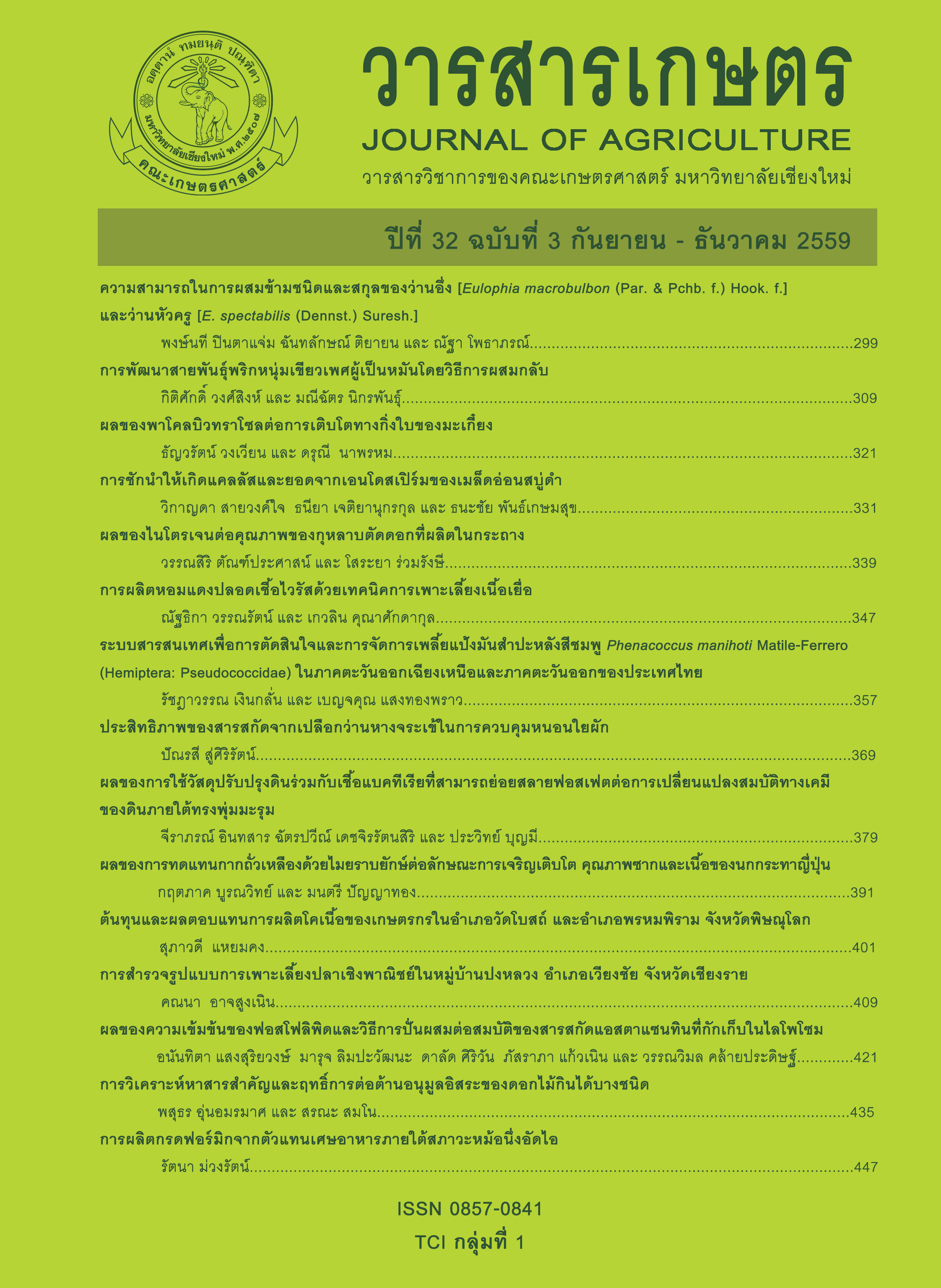ผลของการทดแทนกากถั่วเหลืองด้วยไมยราบยักษ์ต่อลักษณะการเจริญเติบโต คุณภาพซากและเนื้อของนกกระทาญี่ปุ่น
Main Article Content
บทคัดย่อ
การทดลองครั้งนี้มีวัตถุประสงค์เพื่อศึกษาผลของการใช้ไมยราบยักษ์ที่ระดับต่างกันเพื่อทดแทนกากถั่วเหลืองต่อลักษณะการเจริญเติบโต ซากและคุณภาพเนื้อบางประการของนกกระทาญี่ปุ่น โดยใช้นกกระทาญี่ปุ่น เพศผู้ อายุ 21 วัน จำนวน 160 ตัว ทำการสุ่มนกกระทาญี่ปุ่นออกเป็น 4 กลุ่ม ให้ได้รับอาหารทดลองที่แตกต่างกัน ได้แก่ กลุ่มควบคุม (T1) กลุ่มที่ได้รับการทดแทนกากถั่วเหลืองด้วยไมยราบยักษ์แห้งป่นที่ระดับ 2, 4 และ 6 เปอร์เซ็นต์ (T2, T3 และ T4 ตามลำดับ) โดยทำการทดลองกลุ่มละ 4 ซ้ำ ๆ ละ 10 ตัว ผลการทดลองพบว่า นกกระทาญี่ปุ่นกลุ่ม T2, T3 และ T4 มีสมรรถภาพการเจริญเติบโตไม่แตกต่างจากกลุ่มควบคุมในทางสถิติ (p>0.05) น้ำหนักมีชีวิตก่อนฆ่าของนกกระทาญี่ปุ่นกลุ่ม T1 มีค่ามากที่สุดอย่างมีนัยสำคัญทางสถิติ (p<0.05) ขณะที่นกกระทาญี่ปุ่นกลุ่ม T3 แสดงแนวโน้มที่จะมีเปอร์เซ็นต์ซากสูงกว่ากลุ่มอื่น ๆ เนื้อของนกกระทาญี่ปุ่นกลุ่ม T2 มีค่า L* มากที่สุด ขณะที่เนื้อของนกกระทาญี่ปุ่นกลุ่ม T3 มีค่า a* และ b* มากที่สุด (p<0.05) เมื่อพิจารณาความสามารถในการอุ้มน้ำของเนื้อพบว่า เนื้อของนกกระทาญี่ปุ่นกลุ่ม T3 และ T4 มีค่าการสูญเสียน้ำขณะเก็บ และค่าการสูญเสียน้ำหลังจากการละลายต่ำที่สุดตามลำดับ (p<0.05) ผลการศึกษาในครั้งนี้แสดงให้เห็นว่า การทดแทนกากถั่วเหลืองด้วยไมยราบยักษ์แห้งป่นที่ระดับ 4 เปอร์เซ็นต์ มีแนวโน้มที่จะช่วยทำให้ลักษณะซากและคุณภาพเนื้อดีที่สุด โดยไม่ส่งเสียต่อสมรรถภาพการเจริญเติบโตของนกกระทาญี่ปุ่น
Article Details
เอกสารอ้างอิง
นรินทร์ ทองวิทยา สุภาภร อิสริโยดม จิระพันธุ์ เมนะคงคา และ วาด วานิช. 2522. ผลของการใช้ใบไมยราบยักษ์ในอาหารนกกระทาไข่. การประชุมทางวิชาการเกษตรศาสตร์และชีววิทยาแห่งชาติ ครั้งที่ 17. 2-7 กุมภาพันธ์ 2522. 519-524.
บุญล้อม ชีวะอิสระกุล และ สุชน ตั้งทวีวิพัฒน์. 2538. การใช้กากงาทดแทนกากถั่วเหลืองในอาหารไก่ไข่. วารสารเกษตร. 11(1): 18-26.
ปิ่น จันจุฬา และ อัจฉรา เพ็งหนู. 2557. การทดแทนกากถั่วเหลืองด้วยกากเนื้อในเมล็ดปาล์มน้ำมันหมักยีสต์ในอาหารข้นต่อการย่อยได้ และความเข้มข้นของกรดไขมันระเหยได้ในกระเพาะรูเมนของแพะ. วารสารเกษตร 30(2): 181-190.
เพิ่มศักดิ์ ศิริวรรณ. 2528. ผลของการใช้ใบไมยราบยักษ์ระดับสูงในอาหารนกกระทาญี่ปุ่น. การประชุมทางวิชาการของมหาวิทยาลัยเกษตรศาสตร์ ครั้งที่ 23. 5-7 กุมภาพันธ์ 2528. 1-15.
วิศิษย์ เกตุปัญญาพงศ์ อับดุลรอฮิม เปาะอีแต และ ฮานีย๊ะ เปาะเย๊าะ. 2551 การเจริญเติบโตและคุณภาพซากของนกกระทาญี่ปุ่นที่กินอาหารเสริมกากกระเจี๊ยบแดง. วารสารมหาวิทยาลัยราชภัฏยะลา. 3(2): 97-105.
วุฒิพันธุ์ เนตรวิชัย อานุภาพ เส็งสาย และ สุรนันท์ น้อยอุทัย. 2554. การใช้ไมยราบยักษ์แห้งเป็นอาหารเสริมในการเลี้ยงแพะพันธุ์ลูกผสมพื้นเมือง. หน้า 137-148. ใน: กมล ริมคีรี (บก.). รายงานผลงานวิจัยกองอาหารสัตว์ ประจำปี พ.ศ. 2554. กรมปศุสัตว์ กระทรวงเกษตรและสหกรณ์, กรุงเทพฯ.
สัญชัย จตุรสิทธา. 2555. เทคโนโลยีเนื้อสัตว์. พิมพ์ครั้งที่ 4. มิ่งเมือง, เชียงใหม่. 367 หน้า.
สุชน ตั้งทวีวิพัฒน์ รุ่งรัตน์ ปิงเมือง และ บุญล้อม ชีวะอิสระกุล. 2544. การใช้กากทานตะวันทดแทนกากถั่วเหลืองในอาหารไก่เนื้อ. วารสารเกษตร 17(3): 230-240.
Adeogun, I.O. and A.A. Adeoye. 2004. Heritabilities and phenotypic correlations of growth performance traits in Japanese quails. Livestock Research for Rural Development 16: 103. (Online). Available: http://www.lrrd.org/lrrd16/12/adeo16103. htm (September 20, 2014).
Alkan, S., K. Karabag, A. Galic, T. Karsli and M.S. Balcioglu. 2010. Determination of body weight and some carcass traits in Japanese quails (Coturnix coturnix japonica) of different lines. Kafkas Üniversitesi Veteriner Fakültesi Dergisi 16(2): 277-280.
AOAC. 2011. Official methods of analysis of AOAC International. 18th ed. AOAC International, Gaithersburg.
Chantiratikul, A., P. Chantiratikul, A. Sangdee, U. Maneechote, C. Bunchasak and O. chinrasri. 2010. Performance and carcass characteristics of Japanese quails fed diets containing Wolffia meal [Wolffia globosa (L.) Wimm.] as a protein replacement for soybean meal. International Journal of Poultry Science 9(6): 562-566.
Denli, M., F. Okan and A.N. Uluocak. 2004. Effect of dietary supplementation of herb essential oils on the growth performance, carcass and intestinal characteristics of quail (Coturnix coturnix japonica). South African Journal of Animal Science 34(3): 174-179.
Elangovan, A.V., A.B. Mandal, P.K. Tyagi, P.K. Tyagi, S. Toppo and T.S. Johri. 2004. Effects of enzymes in diets with varying energy levels on growth and egg production performance of Japanese quail. Journal of the Science of Food and Agriculture 84: 2028-2034.
Fletcher, D.L. 1999. Broiler breast meat color variation, pH, and texture. Poultry Science 78: 1323-1327.
Genchev, A. and R. Mihaylov. 2008. Slaughter analysis protocol in experiments using Japanese quails (Coturnix japonica). Trakia Journal of Sciences 6(4): 66-71.
Genchev, A., G. Mihaylova, S. Ribarski, A. Pavlov and M. Kabakchiev. 2008. Meat quality and composition in Japanese quails. Trakia Journal of Sciences 6(4): 72-82.
Genchev, A., S. Ribarski and G. Zhelyazkov. 2010. Physicochemical and technological properties of Japanese quail meat. Trakia Journal of Sciences 8(4): 86-94.
Jatoi, A.S., S. Mehmood, J. Hussain, H.M. Ishaq, Y. Abbas and M. Akram. 2015. Comparison of six-week growth performance in four different strains of Japanese quail (Coturnix coturnix japonica). Sarhad Journal of Agriculture 31(1): 59-64.
Miller, I.L. 2002. Uses for Mimosa pigra. Research and Management of Mimosa pigra, the 3rd International Symposium on the Management of Mimosa pigra. Darwin, Australia. 22-25 September 2002. 63-67.
Nakkitset, S., C. Mikled and I. Ledin. 2008. Effect of feeding head lettuce, water spinach, ruzi grass or Mimosa pigra on feed intake, digestibility and growth in rabbits. Asian-Australasian Journal of Animal Sciences 21(8): 1171-1177.
Narinc, D., E. Karaman and T. Aksoy. 2014. Effects of slaughter age and mass selection on slaughter and carcass characteristics in 2 lines of Japanese quail. Poultry Science 93: 762-769.
Narinc, D., T. Aksoy, E. Karaman, A. Aygun, M.Z. Firat and M.K. Uslu. 2013. Japanese quail meat quality: Characteristics, heritabilities, and genetic correlations with some slaughter traits. Poultry Science 92: 1735-1744.
NRC. 1994. Nutrient requirements of poultry. 9th revised ed. National Academy Press, Washington D.C. 155 p.
Ozbey, O. and M. Ozcelik. 2004. The effect of high environmental temperature on growth performance of Japanese quails with different body weights. International Journal of Poultry Science 3(7): 468-470.
R Core Team. 2015. R: A language and environment for statistical computing. R Foundation for Statistical Computing, Vienna, Austria. (Online). Available: http://www.R-project.org/ (August 14, 2015).
Rabie M.H. and H.M.A. El-Maaty. 2015. Growth performance of Japanese quail as affected by dietary protein level and enzyme supplementation. Asian Journal of Animal and Veterinary Advances 10(2): 74-85.
Sarıçiçek, B.Z., U. Kılıç and A.V. Garipoğlu. 2005. Replacing soybean meal (SBM) by canola meal (CM): The effects of multi-enzyme and phytase supplementation on the performance of growing and laying quails. Asian-Australasian Journal of Animal Sciences 18(10): 1457-1463.
Sartowska, K.E., A. Korwin-Kossakowska and G. Sender. 2015. Genetically modified crops in a 10-generation feeding trial on Japanese quails-Evaluation of its influence on birds’ performance and body composition. Poultry Science 94: 2909-2916.
Soares, R., J.B. Fonseca, A.S. Santos and M.B. Mercandante. 2003. Protein requirement of Japanese quail (Coturnix coturnix japonica) during rearing and laying periods. Revista Brasileira de Ciência Avícola 5(2): 153-156.
Van Laack, R.L.J.M., C.-H. Liu, M.O. Smith and H.D. Loveday. 2000. Characteristics of pale, soft, exudative broiler breast meat. Poultry Science 79: 1057-1061.


